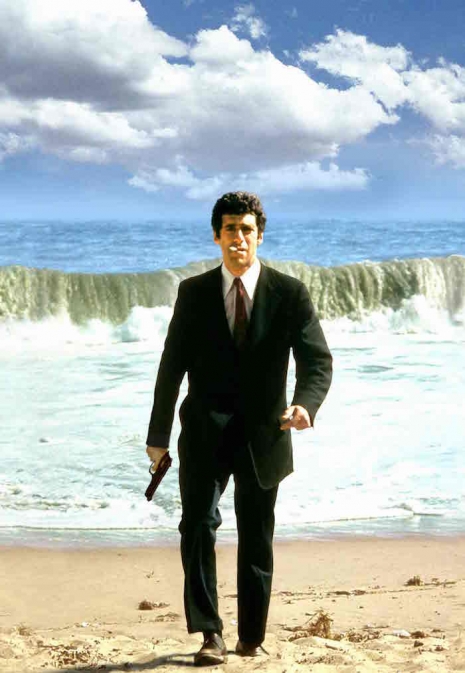
Elliott Gould as Philip Marlowe in Robert Altman’s film version of Raymond Chandler’s ‘The Long Goodbye.’
Raymond Chandler wanted to call his second Philip Marlowe novel The Second Murderer. His publisher Blanche Knopf nixed the idea. So, Chandler suggested Zounds, He Dies, a line spoken by the Second Murderer in Shakespeare’s King Richard III.
Knopf was deeply unimpressed. Eventually, the pair agreed on Farewell, My Lovely which is one hell of a killer title.
This is one of those little sidebars of information contained in Raymond Chandler’s Notebooks which were published long after the great man’s death in 1977. Chandler kept a variety of notebooks during his life. Usually small leather pocketbooks or large writing pads filled with daily events, observations, private thoughts, and details of work in progress. Unfortunately, the bulk of these notebooks was destroyed by Chandler when he was preparing to move to England after his wife Cissy’s death in 1954. Only two notebooks survived. Extracts from these two volumes supplied the content for The Notebooks of Raymond Chandler.
On occasion, Chandler has been unfairly given the rap that he was never as good as his rival Dashiell Hammett, as he made crime writing more about imagination than real hard-bitten, hard-earned experience. Hammett had been a Pinkerton detective. Chandler was a drunk oil exec down on his luck. He was a “gasbag,” according to the Demon Dog James Ellroy. His fictional hero Philip Marlowe was paraded through a series of hoops and jumps which were sometimes incoherent. It’s not a view I would ever agree with. I prefer Chandler to Hammett but think both writers took their writing very seriously.
This can be seen from what’s left of Chandler’s notebooks. He was a very serious writer, who worked damned hard at getting things just exactly right. In his notebooks, he practiced his writing and tried out his ideas. He also used them as a source book for research. From lists of street slang to working out titles, similes, and even writing parodies of other authors like Ernest Hemingway.
Among the many book titles listed in the two remaining notebooks are such unlikely gems:
The Man with the Shredded Ear
All Guns are Loaded
The Corpse Came in Person
They Only Murdered Him Once
The Diary of a Loud Check Suit
Quick, Hide the Body
Stop Screaming—It’s Me
The Black-Eyed Blonde
Thunder-Bug
Everyone Says Good-bye Too Soon
You get the idea Chandler was a fun guy if just a little too shy to get the party swinging.
What interested me about Chandler’s notebooks (well, apart from his notes on writing crime fiction) were the long lists of slang he compiled from the streets and from newspapers, a few of which I’ve shared below.
Pickpocket Lingo
(Maybe New York only)
Saturday Evening Post, October 21, 1950
Cannon—General term for pickpocket (Dip is unused, obsolete)
Live cannon—A thief who works on normally situated people, as opposed to a roller (a lushworker) who frisks drunks. Both men knock their victims. Rousters walk with the victim pretending to help; sneak workers don’t touch him unless he is passed out or near to it.
Pit worker—Inside-breast-pocket expert.
Moll buzzer—Operator on women’s handbags.
Sneeze—Arrest.
Short—Bus, street car, any public conveyance.
Stride—Walking (“On the stride.”)
Shed—Railroad station.
Tip—Crowd.
Bridge—Pocket.
Button—Police badge.
Kiss the dog—Work face to face with the victim.
Tail pits—Right and left side pockets of jacket.
Pratt—Rear trouser pocket.
Stall—Accomplice who creates confusion to fix the victim’s attention.
Right fall—Grand larceny conviction. To obtain there must be testimony that the accused had his hand in the victim’s pocket and was caught with the goods still on him. Most arrests are for “jostling,” which is a misdemeanor good for no more than six bits (months). A shove is enough when the shover is a known operator.
Hanger binging—Opening women’s handbags without stealing the bag.
Tweezer—Change purse.
Stiff—A newspaper or other shield to hide operations.
Wire or hook—The actual live cannon, as opposed to the stall.
Shot—A young pickpocket just starting to work (Harlem cant).
Fan the scratch—To locate money in a pocket without putting the hand in, i.e., by touch.
Dunnigan worker—Thieves who hang around comfort stations hoping for a coat left on a hook.
Note: A cannon never takes your money. He forks his fingers over it and moves away from it with a shove.

The great Raymond Chandler.
More slang from Chandler’s notebooks, after the jump…






